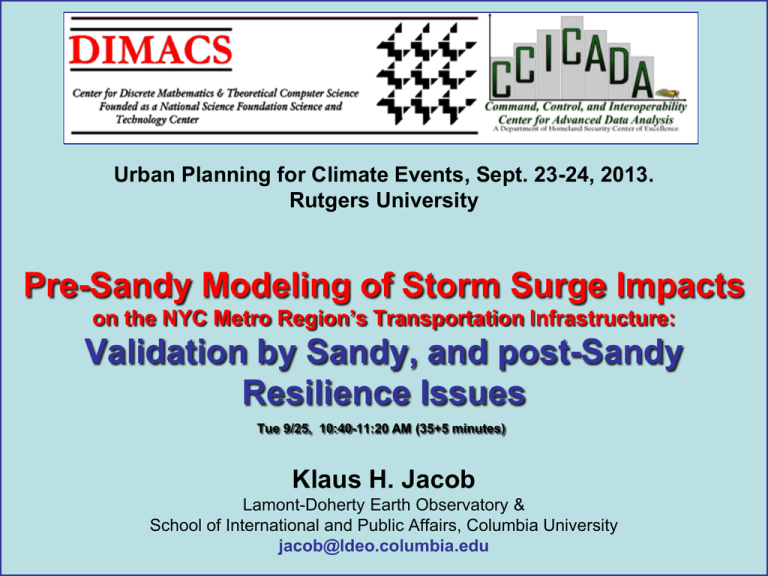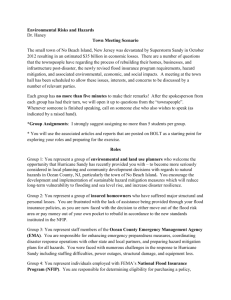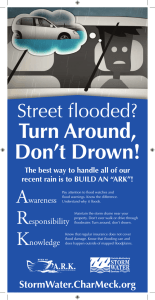Pre-Sandy Modeling of Storm Surge Impacts on the NYC Metro Region's Transportation Infrastructure: Validation by Sandy, and post-Sandy Resilience Issues
advertisement

Urban Planning for Climate Events, Sept. 23-24, 2013. Rutgers University Pre-Sandy Modeling of Storm Surge Impacts on the NYC Metro Region’s Transportation Infrastructure: Validation by Sandy, and post-Sandy Resilience Issues Tue 9/25, 10:40-11:20 AM (35+5 minutes) Klaus H. Jacob Lamont-Doherty Earth Observatory & School of International and Public Affairs, Columbia University jacob@ldeo.columbia.edu Topics: • Pre-Sandy Forecasts • Sandy Impacts • Post Sandy Issues • Long-term Issues SIRR June 11, 2013 ClimAID, Chapter 9: Transportation. Jacob et al. 2011 Red 100-y flood in 2000 (surge of ~ 8ft). S1 S2 100-y flood in 2040s, with +2ft SLR Yel Grn 100-y flood in 2080s, with +4ft SLR S3 ClimAID, Chapter 9: Transportation. Jacob et al. 2011 ClimAID, Chapter 9: Transportation. Jacob et al. 2011 ClimAID, Chapter 9: Transportation. Jacob et al. 2011 ClimAID Study: Chapter 9 – Transportation. (Jacob et al. December 2011) • What is the expected direct damage from the 100yr flood to the transportation infrastructure ? ~ $ 10 Billion • How long will it take for the various components of infrastructure to have their services restored ? ~3 weeks (at ~ $ 4B/day =>) • What will be potential economic losses from the transportation outages and extended restoration times ? ~ $ 60 Billion (+ Losses to Building Stock) Preparations for Irene, Downtown Manhattan Subway Grates & Penn Station MTA LIRR yard SANDY Oct 29, 2012 11.0 ft 8.9 ft 0.2%/yr BFE 1%/yr BFE 11.3 ft 2.5ft SANDY FLOOD PATH – FLOODING OF THE BBT 12 DEWATERING FROM GIVB FRESH AIR SHAFTS Maximum dewatering achieved from GIVB fresh air shaft way. Dewatering operations at GIVB, Manhattan Plaza, and BVB Pump Room were TUNNEL ELEMENTS & SYSTEMS – ALL AFFECTED BY SANDY BBT & QMT VENEER CEILING PANEL REMOVAL • • Removed over 12,000 veneer suspended ceiling panels at the BBT that were compromised by contaminated saltwater. Oil and salt have totally destroyed the thin aluminum sandwich panel veneer system. Removed over 2600 veneer ceiling panels at the QMT BBT WITH CEILING PANEL REMOVAL Verizon Central Offices, 140 West Street, Manhattan SIRR June 11, 2013 3 Basic Modes of Adaptation: • Protection • Accommodation • Strategic Retreat NPCC2: June 11, 2013 Proposed: 2 - 4 New York Barriers London’s Thames Barriers Rotterdam Flood Barriers Proposed NY Barriers Barriers Probably Unsustainable. Why? 15 Contribution to SLR from Greenland Ice Sheet As a function of average temperature increase 12 ? Total SLR 9 6 3 ft Recent and future climatic extremes: consequences for the Netherlands Rockaways Thinking Outside the Box: More NYC “High-Lines” ? The good Message is (from MMC Study, see below): For every $1 invested in Disaster Loss Mitigation & Prevention there is, on Average, a Return of ~$4 Saved in NOT Incurred Losses. National Institute of Building Science Multi-hazard Mitigation Council (NIBS/MMC) Study “Mitigation Saves”: http://www.nibs.org/MMC/MitigationSavingsReport/natural_hazard_mitigation_saves.htm Some final thoughts on Sustainable Resilience: • Sustainable design minimizes liabilities for future generations => Intergenerational equity and justice. • Design for “Higher Ground”: avoid putting new assets into current and future flood planes near sea level. • Sustainable design => adaptive designs (=> floats). • Design for sustained functionality during system life time and respective sea levels: adaptive transport elevations, pathways and accessibility, mass transit, utilities (water, sewer, electric, gas, telecommunication). • Think and design long term, then design short term solutions (to assist transformation to long-term conditions). No Timing makes a Difference.





